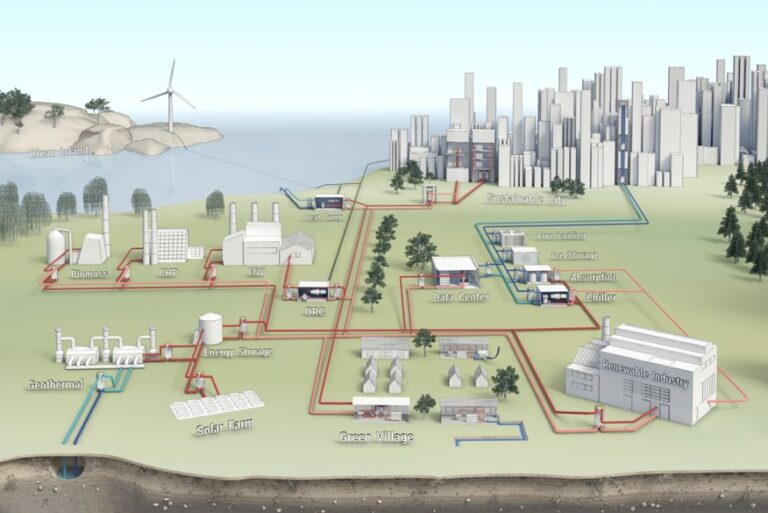This article originally appeared in the May/June 2019 issue of FMJ
In 1760, the First Industrial Revolution swept throughout Britain and the rest of the world, shifting the burden of construction and manufacturing from consumer to enterprise. Until that time, people were responsible for spinning their own cloth and crafting their own furniture. The invention of the steam engine — and its subsequent role in powering manufacturing equipment, automobiles and ships decades later — created a new standard of living for people throughout the world and reshaped nations’ economies.
More than 250 years and two more industrial revolutions later, humanity has come full circle from a revolution built on consuming water to a revolution with the potential to save it.
The height of the Fourth Industrial Revolution is nigh upon us, and not a moment too soon. A growing population, increasing global energy consumption and humanity’s exacerbation of climate change are all affecting Earth’s most precious resource: its water.
‘Til death do we part
The World Economic Forum characterizes the Fourth Industrial Revolution1 as “a fusion of technologies that is blurring the lines between the physical, digital and biological spheres.” In many ways it is the redistribution of knowledge through newly created delivery mechanisms that have proliferated at an exponential pace in the last few decades. For instance, the processing power of the device on which you’re reading this article was unimaginable when the first computers were invented. This is a noteworthy example of the rate at which technology is advancing in the 21st century.
In 2001, American inventor and futurist Ray Kurzweil published an essay called “The Law of Accelerating Returns,” in which he posits that technology advances at an exponential — rather than “intuitive linear” — rate. Each subsequent wave of innovation and advancement essentially piggybacks on the wave that preceded it, much like how a tsunami’s force is compounded as successive waves reach shore. In fact, Kurzweil predicted, “We won’t experience 100 years of progression in the 21st century — it will be more like 20,000 years of progress at today’s rate.”
One need only look at the rapid advancements in machine learning, artificial intelligence, powerful data analytics and the Internet of Things to see the truth of his hypothesis. It is just as clear that humanity will never return to an age where the physical, digital and biological were distinctly separate. The marriage of these three worlds is now quintessential to energy production and conservation and, by extension, our species’ survival in coming generations.
Symbiosis
Water is the key ingredient in the traditional paradigms of energy production.3 It is used to cool coal and nuclear power plants; to drill, mine and refine oil, uranium and natural gas; to transport energy sources through pipelines; to test those pipelines for leaks; and to act as a method of pollution control at thermoelectric plants. According to the Union of Concerned Scientists, one kilowatt-hour of electricity requires up to 60 gallons of water at coal and nuclear plants.
In fact, according to their estimates, “electric power generation is responsible for almost 40 percent of freshwater withdrawals in the United States.” Similarly, “around 65 percent of U.S. electricity comes from power generators that need cooling.”
Reasons to Reduce Water Consumption
Saving water does more than just help the environment. It is also simply good business practice. Here’s how reducing consumption improves the bottom line:
- Risk Mitigation
Any savvy businessperson knows mitigating risks leads to higher profits. By
eliminating chance, it is easier to reach a desired outcome. In terms of resource consumption,
the risk of natural disaster, climate change, supply chain failure or geopolitical struggle could all drastically impact the availability and cost of electricity, gas and water. By minimizing demand, an organization inherently mitigates its exposure to these risks. - “Trickle Up” Sustainability
It can be easy to forget the interconnectedness of electricity, gas and water. Water treatment
and delivery has massive energy demand. Gas extraction and refinement requires large amounts of water. End users, by reducing their personal consumption, also reduce the overall footprint by a factor much larger than what’s shown on a monthly bill. Those savings, in turn, trickle all the way up the supply chain to help preserve resources yet to be extracted. - Cost Savings
Arguably the simplest reason to reduce resource demand is that it saves money. By employing
the most efficient means to operating a business, owners and operators will cut costs
dramatically. Although implementing systems for demand reduction can, at times, involve large upfront investments, IoT tools can provide tangible return on investment feedback to ensure the investment is recouped, and the utility bills fall. For commercial realty owners, that feedback powerfully effects NOI and property value.
Under current models, the water required to produce energy — of which global consumption has increased by 70,000 terawatt-hours in less than 40 years — will soon become unsustainable. Humans consumed about 150,000 terawatt-hours of energy in 2016, the majority of which came from traditional sources like coal, crude oil and natural gas.4
As power becomes more and more accessible to larger portions of the global populace, and as the population increases at about 3.4 percent per year5, the U.S. Energy Information Administration projects that overall energy consumption on Earth will increase 28 percent by 2040.6
When considered in the context of growing drought made worse by humanity’s acceleration of climate change, the demand for water will increase drastically while our ability to source, supply and deliver it becomes more difficult.
Enter the Fourth Industrial Revolution.
The democratization of sustainability
Amidst the backdrop of increasing global resource demand and consumption and the grim reality of previous industrial revolutions’ collective effect on our planet, the Fourth Industrial Revolution has a unique place in history. It has the opportunity to save and optimize the remaining resources our planet has left to give. The companies that seize this opportunity and implement new technologies to conserve resources like energy and water are the ones that will thrive in the decades to come.
To that effect, the World Economic Forum writes7, “Companies, international organizations and governments still need to establish how they can work together to improve their water management.” This is true across every single industry, whether a business is B2C or B2B, whether they’re headquartered in New York or Nairobi. Never before has a wave of innovation created such a ubiquitous and lucrative opportunity for humanity to save the very thing that keeps us alive.
The opportunities this revolution provides are not just limited to corporations. In the age of globalization, consumers have a louder collective voice than at any point in the past. It’s time to use it to support businesses that use technology to create a socially responsible enterprise and to shun those that continue to pollute our planet unnecessarily and consume its resources unabated. Sustainability, as we’ve seen, can be accomplished with our wallets as well as our brains.
Humanity is at a unique crossroads in its history. Until now, widespread innovation traditionally came at the cost of Earth’s resources. Now, finally, 250 years later, it can be used to save them.
Resources
- weforum.org/agenda/2016/01/the-fourth-industrial-revolution-what-it-means-and-how-to-respond
- kurzweilai.net/the-law-of-accelerating-returns
- ucsusa.org/clean-energy/energy-water-use/water-energy-electricity-overview#.WoXD-pPwais
- https://ourworldindata.org/energy-production-and-changing-energy-sources
- iea.org/weo2017
- eia.gov/todayinenergy/detail.php?id=32912
- weforum.org/agenda/2016/06/sustainable-consumption-and-the-fourth-industrial-revolution






